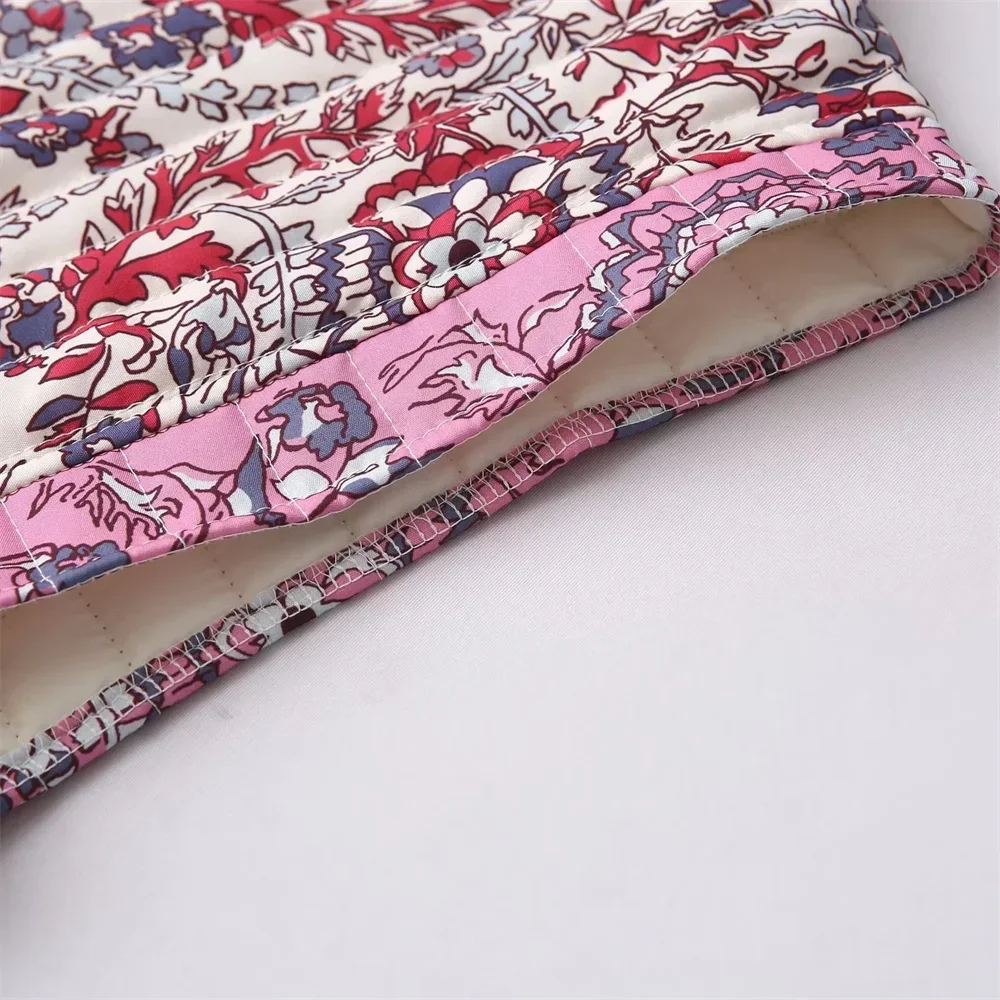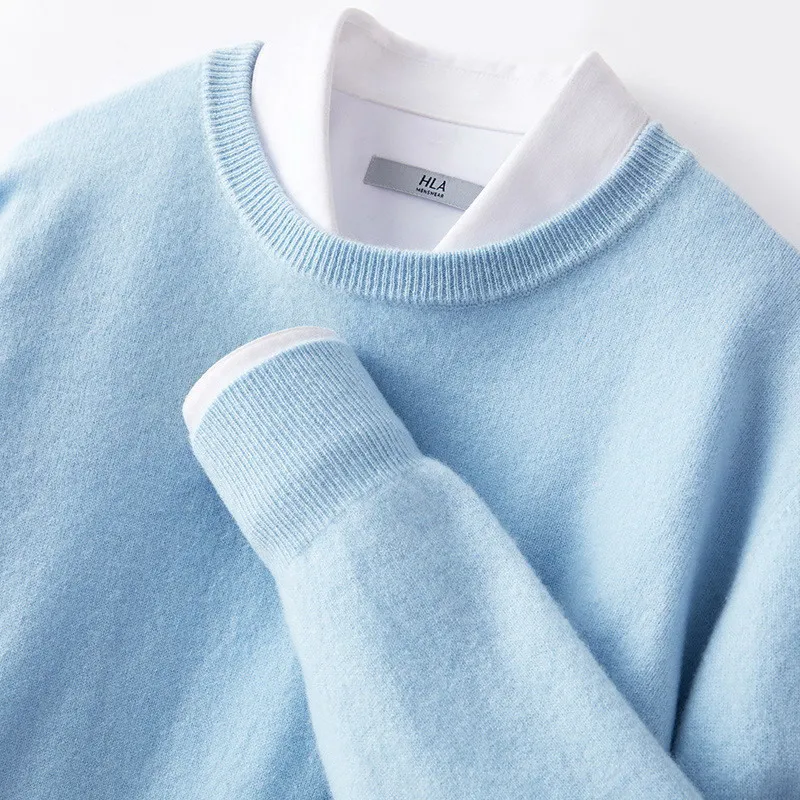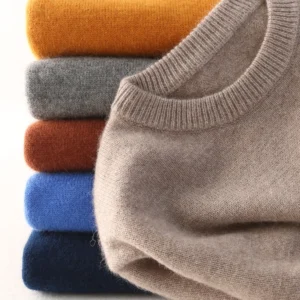Introduction: Understanding Premium Cashmere Origins
Cashmere stands as one of the world’s most coveted luxury textiles, prized for its extraordinary combination of lightweight feel, exceptional warmth, and incomparable softness. Throughout history, this precious fiber has been treasured by royalty and the elite, often considered “worth its weight in gold” for its remarkable qualities and limited availability.
What makes cashmere truly special is its origin story – the downy undercoat of certain breeds of goats that develop this incredibly fine fiber as protection against harsh winter conditions. The quality of cashmere depends on several critical factors: the fineness of the fiber (measured in microns), the length of individual fibers, and the processing techniques used to transform the raw material into finished garments.
In the world of premium cashmere, two sources have established themselves as paragons of excellence, each representing different aspects of quality: Mongolian cashmere, renowned for the exceptional raw material from high-plateau goats, and Scottish cashmere, celebrated for unparalleled processing expertise refined over centuries of textile tradition.
This guide aims to unravel the distinctions between these two cashmere powerhouses, helping you understand the unique value propositions of each. Whether you’re considering your first cashmere investment or looking to expand your knowledge of styling tips for cashmere cardigans, understanding these differences will empower you to make more informed decisions when selecting premium cashmere garments.
The Source: Mongolian Cashmere’s Natural Excellence
Mongolia’s geography creates the perfect environment for producing exceptional cashmere. The vast Gobi Desert region subjects its inhabitants to some of the planet’s most extreme temperature variations – from bitter winters reaching -40°F (-40°C) to scorching summers exceeding 104°F (40°C). This harsh climate has fostered evolutionary adaptations in Mongolian cashmere goats that directly translate to superior fiber quality.
Climate-Driven Quality
The Mongolian cashmere goat has evolved to survive these conditions by developing an extraordinarily fine, dense undercoat beneath its coarser outer hair. This undercoat – what we know as cashmere – functions as natural insulation, with fibers averaging just 14-16 microns in diameter (for perspective, human hair typically measures 50-70 microns). The extreme cold also promotes longer fiber development, with Mongolian cashmere typically featuring fibers between 36-50mm (1.5-2 inches), contributing significantly to strength and durability.
Traditional Harvesting Methods
Mongolian herders maintain ancient harvesting techniques that preserve the integrity of this precious resource:
- Hand-combing during spring molting season rather than shearing
- Careful separation of the fine undercoat from coarser guard hairs
- Initial sorting by experienced herders who can distinguish quality by touch
- Preservation techniques that maintain fiber length and prevent damage
This human-centered approach to harvesting creates minimal stress for the animals while maximizing the quality of the collected fibers. The result is raw cashmere with exceptional natural properties – a true testament to Mongolia’s harmonious relationship with its harsh environment.
The extraordinary qualities of these raw fibers make them particularly sought-after for creating premium cashmere sweaters that retain the material’s natural character while providing unmatched comfort.
The Craft: Scottish Cashmere’s Processing Excellence
While Mongolia excels in producing exceptional raw cashmere, Scotland has established itself as the global leader in cashmere processing, refining, and manufacturing. This expertise didn’t develop overnight – it represents centuries of textile innovation dating back to the early industrial revolution when Scottish mills began developing specialized techniques for working with fine fibers.
Scottish cashmere begins with carefully selected raw fibers, often sourced from Mongolia and other premium growing regions. What makes Scottish processing distinctive is the meticulous multi-step journey these fibers undergo:
The Scottish Processing Advantage
The transformation begins with washing and scouring using Scotland’s famously soft water. This regional water quality, naturally low in minerals, allows for gentle yet thorough cleaning that preserves fiber integrity while removing impurities. After cleaning, the fibers undergo precision dehairing – a critical process where specialized machines separate the fine cashmere from any remaining guard hairs.
The spinning phase showcases Scottish expertise, with techniques developed over generations to create yarns of remarkable consistency and strength. Scottish mills employ both traditional and cutting-edge technologies to produce yarns with optimal twist levels that balance strength with softness.
Perhaps most distinctive are the finishing processes. Scottish cashmere undergoes multiple finishing steps including teaseling (raising the surface fibers) and brushing to create that characteristic soft halo effect. Specialized pressing and steam treatments help set the fibers and enhance drape. Many brushed cashmere sweaters utilize these techniques to achieve their luxuriously soft feel against the skin.
This painstaking attention to process refinement means Scottish cashmere often exhibits enhanced qualities beyond what’s inherent in the raw material – improved pill-resistance, greater dimensional stability, more consistent coloration, and a distinctly refined handle (industry term for how fabric feels to touch).
Fiber Characteristics: A Direct Comparison

When examining Mongolian and Scottish cashmere side by side, several key differences emerge in their fundamental characteristics:
| Characteristic | Mongolian Cashmere | Scottish Cashmere |
|---|---|---|
| Fiber Fineness | 14-16 microns (raw) | 14-16 microns (processed) |
| Fiber Length | 36-50mm typically | Enhanced through processing |
| Natural Feel | More rustic, authentic character | Refined, consistent hand feel |
| Surface Texture | Variable natural halo | Controlled, even surface |
| Color Range | Excellent for natural shades | Superior dyeing consistency |
| Warmth-to-Weight | Exceptional natural insulation | Enhanced through processing |
The differences stem primarily from emphasis: Mongolian cashmere celebrates the exceptional natural qualities of the raw fiber, while Scottish cashmere focuses on enhancing these natural properties through sophisticated processing.
The raw fiber quality from Mongolia provides the foundation for exceptional cashmere, but Scottish processing techniques can elevate even good fiber to greatness through their refinement process. For those interested in deeper technical details about these distinctions, our detailed comparison guide explores the science behind these differences.
Durability and Longevity: The Pilling Question
Pilling – those small fuzzy balls that can form on the surface of cashmere garments – represents one of the primary durability concerns for cashmere owners. Understanding how Mongolian and Scottish cashmere differ in this regard helps set realistic expectations.
Pilling occurs when shorter fibers work their way to the surface during wear and form small balls or knots. Several factors influence pilling tendency:
- Fiber length (longer fibers pill less)
- Processing techniques (proper fiber alignment reduces pilling)
- Yarn construction (tighter spinning typically creates more pill-resistant fabrics)
- Finishing methods (some finishes can reduce surface fiber movement)
Scottish cashmere generally demonstrates greater pill-resistance due to specialized processing techniques that optimize fiber alignment and create more stable yarn structures. The multiple-step finishing processes used in Scottish production can also contribute to reduced pilling by stabilizing surface fibers.
Mongolian cashmere, when processed with less intervention, may exhibit more natural pilling initially but often stabilizes after the shortest fibers work their way out. Many connoisseurs appreciate this “breaking in” process as part of the natural character development of the garment.
Regardless of origin, proper long-term cashmere garment care remains essential for maximizing longevity. Both types will last for many years when maintained correctly, though Scottish processing may provide an edge in maintaining appearance through intensive wear.
The Aesthetic Experience: Feel, Drape, and Appearance
The sensory experience of cashmere represents one of its most compelling attributes, and here the differences between Mongolian and Scottish varieties become most apparent to the average wearer.
Mongolian cashmere, when processed with minimal intervention, often retains more of its natural character. This translates to a slightly more rustic hand feel with greater variation in texture – what some describe as a more authentic cashmere experience. The natural crimp of the fiber creates exceptional loft and a distinctive drape that moves naturally with the body.
Scottish-processed cashmere delivers remarkable consistency in feel, with an almost impossibly smooth surface and refined drape. The intensive finishing processes create a more uniform appearance with excellent stitch definition that showcases complex knitting patterns. Scottish cashmere typically offers superior color consistency throughout the garment due to advanced dyeing techniques.
These aesthetic differences make each type suited to different applications. The natural character of minimally-processed Mongolian cashmere excels in relaxed, comfortable pieces where texture adds interest. The refined polish of Scottish cashmere shines in men’s cashmere pullovers and more structured garments where precision and drape are paramount.
Neither approach is inherently superior – they simply offer different aesthetic experiences that appeal to different preferences and applications.
The Value Proposition: Understanding Price Differences

The often substantial price difference between Mongolian and Scottish cashmere stems from multiple factors beyond simple quality distinctions:
Cost Factors in Cashmere Production
- Raw Material Sourcing: Premium cashmere always commands higher prices, regardless of origin
- Processing Complexity: Scottish methods involve more steps and specialized equipment
- Labor Intensity: Scottish processing typically requires more skilled labor hours per garment
- Quality Control: Rigorous standards at multiple production stages increase costs
- Brand Positioning: Heritage and reputation often factor into pricing strategy
Scottish cashmere frequently commands premium pricing due to its processing sophistication, established reputation, and the higher labor costs associated with European production. Mongolian cashmere, while still premium compared to standard wool, may offer better initial value for those prioritizing the essential qualities of cashmere.
When evaluating value, consider the concept of “cost-per-wear” – a $300 sweater worn 100 times costs $3 per use, while a $150 sweater worn 30 times costs $5 per use. Premium cashmere’s longevity often makes it the better long-term value despite higher initial investment.
Cashmere Wrap Sweaters, Women's Cashmere Pullovers
$75.89 Select options This product has multiple variants. The options may be chosen on the product pageCashmere Cable Knit Sweaters, Women's Cashmere Pullovers
Price range: $111.82 through $112.93 Select options This product has multiple variants. The options may be chosen on the product pageCropped Cashmere Sweaters, Women's Cashmere Pullovers
$155.77 Select options This product has multiple variants. The options may be chosen on the product pageOversized Cashmere Sweaters, Plus Size Cashmere Sweaters, Women's V-Neck Cashmere Sweaters
$136.87 Select options This product has multiple variants. The options may be chosen on the product pageStriped Cashmere Sweaters, Women's Cashmere Pullovers
$139.68 Select options This product has multiple variants. The options may be chosen on the product pageMen's Cashmere Pullovers, Men's V-Neck Cashmere Sweaters
Price range: $90.79 through $96.98 Select options This product has multiple variants. The options may be chosen on the product page
Quality Assessment: What To Look For When Shopping
Regardless of whether you’re considering Mongolian or Scottish cashmere, certain universal indicators help identify quality pieces worth your investment:
Cashmere Grading Indicators
- Grade Terminology: Grade A cashmere features fibers under 16 microns and minimum 36mm length. Grade B measures 16-19 microns. Grade C exceeds 19 microns with shorter fibers.
- Ply Count: Two-ply or higher cashmere (two or more yarns twisted together) generally offers better durability and shape retention than single-ply.
- Gauge: The knitting density affects weight and drape. Fine gauge creates lightweight, dressier garments, while heavy gauge produces more substantial pieces.
- Construction Details: Examine seams, finishing, and how the garment is assembled – quality cashmere deserves quality construction.
Simple Quality Tests
When examining potential purchases, try these simple assessments:
- The Pill Test: Gently rub the surface – excessive fiber shedding indicates poor quality
- The Recovery Test: Stretch the fabric slightly and release – quality cashmere springs back quickly
- The Light Test: Hold up to light – even density without thin spots suggests good construction
- The Feel Test: Quality cashmere feels soft yet substantial, never slippery or scratchy
Learning to identify quality indicators helps determine whether cashmere cardigans are worth the investment, regardless of their Mongolian or Scottish origin.
Sustainability and Ethics: Considerations Beyond Quality
Today’s conscious consumers increasingly consider the environmental and ethical implications of their purchases alongside traditional quality metrics.
Environmental Considerations
- Mongolian Herding Practices: Traditional nomadic herding can be sustainable when properly managed but faces challenges from increased herd sizes and climate change.
- Processing Resource Usage: Scottish processing requires more energy and water but often employs more advanced waste management systems.
- Longevity Impact: Higher-quality cashmere from either source creates less environmental impact through extended useful life.
Ethical Supply Chain Factors
- Animal Welfare: Look for suppliers committed to humane harvesting practices (combing rather than shearing).
- Labor Conditions: Both production methods involve human labor at multiple stages – transparency about working conditions matters.
- Community Impact: Supporting traditional herding communities helps preserve cultural heritage and sustainable practices.
Various certification programs are emerging to help identify responsible cashmere production methods, though the industry is still developing comprehensive standards. Estate Cloth emphasizes quality partly because well-made garments that last for years represent inherently more sustainable choices than frequently replaced fast fashion.
Making Your Choice: Which Cashmere Is Right For You?

Your ideal cashmere choice ultimately depends on your personal preferences, priorities, and intended use:
Consider Mongolian cashmere (with less intensive processing) if you:
* Appreciate natural character and subtle variations in your luxury items
* Prefer maximum softness from the first wear
* Value traditional production methods and direct connection to the source
* Enjoy how cashmere develops character over time
Consider Scottish cashmere if you:
* Prioritize refined finishing and consistent appearance
* Need maximum durability for everyday professional wear
* Appreciate precision in fit and drape
* Value heritage techniques and established craftsmanship
For specific applications:
* Everyday comfort pieces often benefit from Mongolian cashmere’s natural softness
* Professional attire may better showcase Scottish cashmere’s refined appearance
* Versatile cashmere cardigan styles work beautifully in either tradition, depending on your preference for polished versus relaxed aesthetics
Many cashmere enthusiasts eventually include both types in their collection, appreciating each for its distinct qualities and appropriate contexts.
Essential Care Guidelines: Preserving Your Investment
Proper care dramatically extends the life of fine cashmere, preserving its exceptional qualities regardless of origin:
Washing and Cleaning
- Hand wash using lukewarm water and specialized cashmere shampoo or mild detergent
- Gently press (never wring) to remove excess water
- For structured garments or when in doubt, professional cleaning may be preferable
Drying and Storage
- Lay flat to dry on a clean towel away from direct heat or sunlight
- Reshape while damp to maintain proper dimensions
- Store folded (never hung) in breathable containers with cedar blocks or lavender sachets to deter moths
Maintenance Practices
- Address pills by gently removing with a cashmere comb or specialized fabric shaver
- Allow 24 hours of rest between wearings to let fibers recover
- Seasonal cleaning before storage prevents moth damage from body oils or food particles
Learning the best way to clean cashmere sweaters ensures your investment pieces maintain their beauty and performance for many years, making either Mongolian or Scottish cashmere a wise long-term choice.
Whether you choose the natural excellence of Mongolian cashmere or the refined sophistication of Scottish processing, understanding these key differences helps you select pieces that best align with your personal preferences and lifestyle needs. The perfect cashmere investment awaits – informed by tradition but perfectly suited to your contemporary life.







